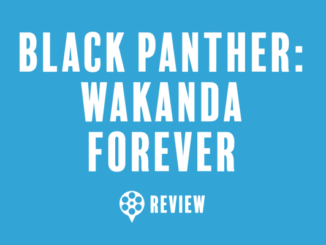With Halloween (2018), the franchise has gone back to its roots. What began as an unnerving exercise in random violence with the 1978 classic began to get bogged down with unnecessary motives and multiple timelines that served to please fans who were looking to choose their own adventure. As a fan, the randomness of the violence in 1978’s Halloween is what makes it truly terrifying. There is no rhyme or reason. It’s a crime of opportunity and the personification of evil taking full advantage of that opportunity by terrorizing a group of friends on a night where he can blend in and go seemingly unnoticed.
For others, they need clarification as to why “The Shape” (Michael Myers) has decided to choose this particular girl, in this case, Laurie Strode (Jamie Lee Curtis), and her group of friends. For those seeking those answers, they were begrudgingly given them in 1981’s Halloween II which factored in the brother/sister connection to explain his bloodlust. Since he killed his older sister Judith in 1963, the family connection is supposed to provide the motive that some moviegoers may have been seeking.
From there we are presented with further sequels that have him going after more of his bloodline and when Jamie Lee Curtis expressed interest in 1998 to see where her character would be 20 years after the events of the first film, it was decided to jettison already established sequels and basically say that Halloween and Halloween II are the only ones that exist. Saying to hell with the pursuit of his young niece in Halloween 4 and 5, Jamie Lee Curtis was back and securing the original “Scream Queen” for the film meant focusing on the journey she started in 1978.
Even if you have a love for Halloween 4 (I know I do!) or you preferred the original Laurie Strode trilogy that spans across Halloween, Halloween II and Halloween H20: 20 Years Later, it’s clear that the choose your own adventure format weighted down the franchise. The narratives became too jumbled and what was lost was the essence that made Michael Myers truly scary, to begin with. By the time we got to the 2007 remake and its 2009 sequel directed by Rob Zombie, Michael was a man who had issues because of a screwed up redneck childhood. Nothing about this, at the core, is what the 1978 version of the character was all about. He was meant to be an enigma and a blank canvas that we projected our own fears upon. The blank stare of his signature white mask and absence of any light in the character is really all you needed to make you uneasy and sense the impending dread.
What director David Gordon Green has done with 2018’s Halloween, along with co-writers Danny McBride and Jeff Fradley, is get back to the core of the fear we experienced with John Carpenter’s 1978 classic. Once again the slate has been wiped clean, with none of the sequels and remakes existing in order to finally tell a proper Halloween story. The difference between ignoring the sequels this time around is that this version of Halloween feels like the natural spiritual successor to the original. They feel like they’re cut from the same cloth and share the same DNA. There is no more brother/sister family drama that is motivating the proceedings. Instead, we’re back to the randomness of violence that set the tone in the first film and what we get here is a twisted, but effective, the case of the one that got away. The act of violence carried out in 1978 has stayed with Laurie, making her a survivor but one that has been plagued with so much trauma it has fractured her most important relationships, all while staying with Michael who, while always silent, seems to crave the satisfaction of acting out on the naive babysitter he randomly pursued in his original quest of evil.
While the movie embraces the malignancy of Michael, it introduces a new dynamic for his surviving 1978 victim. In 1998’s H20, we saw one vision of the PTSD-suffering Laurie. Here, we get a slightly different interpretation. This Laurie is a cold, brutal avenging angel. She’s the spiritual successor of Dr. Loomis, believing that the only solution for Michael is to kill him. As a result, Halloween introduces something rarely explored in slasher movies: victim empowerment. Laurie doesn’t fear Michael any more than she fears death. She was the hunted in 1978; forty years later, she’s the hunter. She may not be entirely polished in her execution, she isn’t supposed to be Ripley by any means, but this is clearly a woman who has prepared for the inevitable and has sacrificed a good chunk of her life to do so.
That sacrifice is represented by her daughter Karen (Judy Greer), who thinks her mom – who drinks too much and lives in an isolated, fortified house – is nuts. Removed from Laurie by social services at the age of 12, Karen has sought to live a “normal” life with her husband, Ray (Toby Huss) and daughter, Allyson (Andi Matichak). But when Michael escapes while being transferred from Smith’s Grove to another asylum, three generations of Strode women have to confront the living nightmare in different ways.
The most refreshing aspect of the new Halloween is the aspect of the three generations of Strode women and the effects of generational trauma that can be afflicted on a family. Laurie’s ordeal made her so hardened over time that she began training her daughter at an early age to essentially be a hunter. Once Karen was removed from her home, it’s clear that when she grew older she chose to distance herself from her mom’s paranoia and has gone out of her way to not pass that on to her own daughter. Allyson represents the young naivety that Laurie once had and it’s something her mother would like her to hold on to. Laurie knows how tragic events can break that part of you and can probably see that girl she once was – that girl not ready for the evils of the world. What transpires, is a fascinating character study that isn’t forced down our throats. It’s clear that eventually, these women will have to come together to face evil but their road to that realization is compelling and something rarely seen in modern day horror films.
Although the film skews toward veteran Halloween lovers, it’s by no means unfriendly to the uninitiated. The newbie’s point-of-entry is provided via a pair of podcasters (played by Rhian Rees and Jefferson Hall) who sketch out Michael’s past – the 1963 murder of his sister, Judith (this is presented using flashbacks from the original Halloween), his condemnation as “pure evil” by his psychiatrist (audio recordings of what’s supposed to be Donald Pleasence but is likely a sound-alike), and his 1978 Halloween night rampage through Haddonfield, Illinois. Those familiar with Carpenter’s movie will note that Green has liberally seeded the 2018 edition with homages. Some are fairly obvious (a girl gazing out her classroom window, a vanishing body, a ghostly apparition, a hovering face, and closets with slatted doors) while others are more subtle. For fans who may be upset that the sequels they loved are being ignored may find some solace that he has given us a few nods from almost all of the Halloween films which should prove to initiate a fun game among hardcore fans.
Mainstream slasher movies during the 1980’s were more about inventive kills and graphic violence than building suspense and sustaining tension – the two qualities that defined Halloween. Carpenter’s sense of atmosphere and uncanny knowledge of how to shoot and edit a scene to maximum effect are still studied by film students today. Green, obviously a true believer, has applied many of the Master’s techniques while introducing a little “modernization.” There are a couple of effective jump-scares and the camera isn’t as reluctant to show the occasional gross-out moment as it was in 1978. Yet there are times, such as during an extended tracking shot where Michael returns home on Halloween night and lets out his pent-up bloodlust, that one could almost imagine Carpenter was behind the camera. David Gordon Green directs the hell out of this film and his love of the genre, particularly the original Halloween, is evident. I can say that none of the sequels have come this close to shooting the film in a way that it seems completely in sync with the first installment. It’s this attention to detail that makes the film work on a similarly visceral level that defined the original. Helping matters is John Carpenter’s score who, with the help of his son, Cody, and Daniel A. Davies has modernized his classic themes to chilling effect in this 2018 effort. Adding to the signature themes we know, he has also created new music that resonates just as strongly. One, in particular, is played during a chase sequence involving Allyson that makes you think this is what “The Shape Stalks Laurie” theme would sound like in this modern era.
At the end of the day, even though Michael Myers is the face of Halloween, this movie is all about Laurie Strode. Jamie Lee Curtis is not just on hand to collect a paycheck. She’s fully committed to the role and you believe that the 1978 version of her would become the hardened person she is today. The key difference in her portrayal between films is that she’s never a victim. She seems to pick up the character from the “do as I say” moment when she tells the young kids she’s babysitting to go get help. At that moment, Laurie is no longer a victim and Curtis makes you believe that she has amplified that sense of empowerment as she has gone through the years, even though it has also made her so obsessed with her situation that it has driven her to isolation.
Initially, Judy Greer seems a tad underused but her arc becomes more apparent during the third act. Greer does a good job of showing the gradual shift of the character from a woman who doesn’t want to succumb to her mom’s paranoia to a woman who realizes her mom was right all along. As Allyson, newcomer Andi Matichak is on top of her game and represents a solid callback to how Curtis played Laurie in 1978. The important thing about the three female leads is that they feel like family, which makes their arcs all the more powerful.
Oddly enough, the male presence in the film is admittedly weak. Will Patton plays a sheriff who appears more bewildered than helpful while Haluk Bilgner is on deck as Dr. Sartain, Michael’s unbalanced doctor. At first, it seems he will be the new Dr. Loomis but a twist takes the character down another path. This is a plot device that doesn’t entirely work because it doesn’t feel very necessary. It was as if it was done to get certain characters from point A to point B. It’s not a total detriment but it represents one of the film’s few missteps. An argument can be made that the podcasters is another misstep but they are a necessary plot device to get the story started, even if their inclusion is a bit clunky. Thankfully the payoff for their characters represents one of the film’s most tension-filled scenes and is another strong showcase for Green’s ability to craft suspenseful sequences.
By making the male element weaker, it only proves to show the strong presence of Michael Myers who, after a lot of sequels that have dulled his impact, is allowed to be scary again. James Jude Courtney is “The Shape” this time around (with a few moments filled in by the original Michael Myers, Nick Castle) and by not overthinking the role (the stuntman/actor has stated in interviews that he didn’t think too much about what motivated him), he’s able to just embody his essence in a way that hasn’t been seen since the 1978 film. This is the character I remember being afraid of as a kid.
The script, much like the 1978 screenplay written by John Carpenter and the late Debra Hill, is strong in its simplicity and it balances between creating moments of dread and solid humor. The babysitting sequence in this film is an example of both with Vicky (Virginia Gardner) taking care of young Julian (Jibrail Nantambu). Their banter is sprinkled with some truly funny dialogue and honestly, Jibrail Nantambu hijacks the scene with his hilarious delivery. Juxtaposed to this is the sense that we know something is coming and by the time he’s telling her to check the closet door, we know we’re being set up for another sequence of true horror. Balancing these two elements is not easy but this creative team does so with ease.
As the weekend hype for Halloween has subsided some, some fans have been arguing that this film isn’t quite what they wanted. I’ve heard people claim H20 was a better experience or at the sequels captured the spirit of Halloween more than this film and here’s what I have to say to that: Everyone is entitled to their opinion and that’s what makes critiquing film so fun BUT the cold hard facts are as technical achievement in filmmaking, Halloween is the best film of this franchise since the original. None of the films have come this close to representing what John Carpenter envisioned in 1978. By dialing it back to what made the 1978 film so memorable, this new Halloween has made Michael Myers the force of evil that began scaring audiences 40 years ago. As a Halloween fan, I’m happy to see him right where he belongs: on the cusp of our very nightmares.






